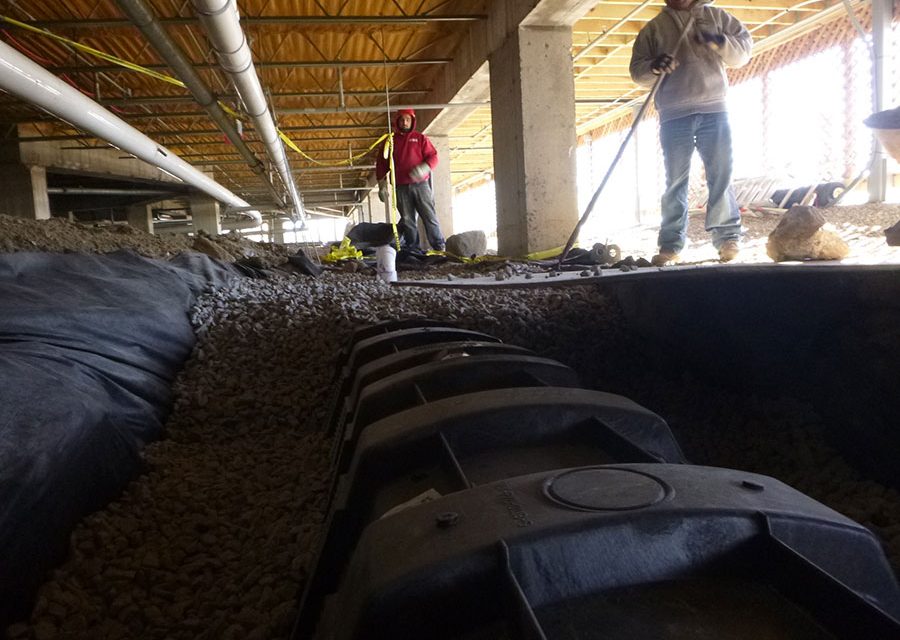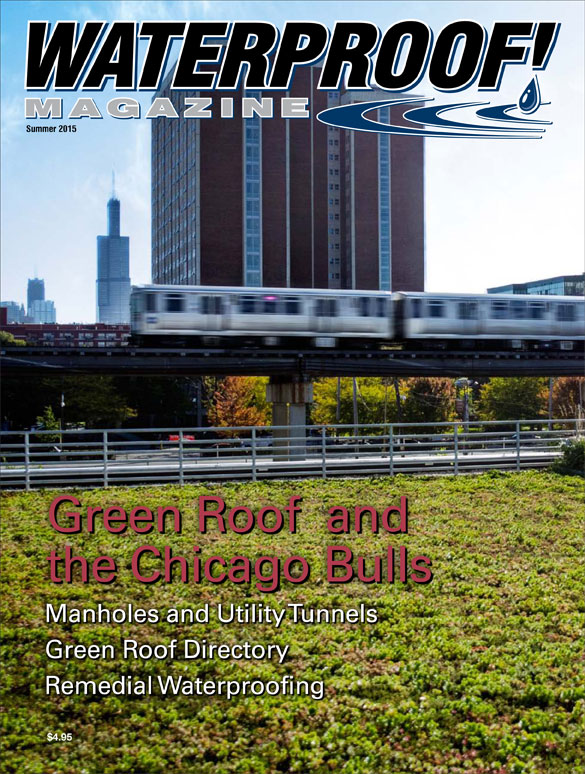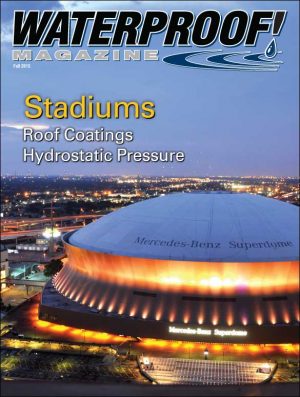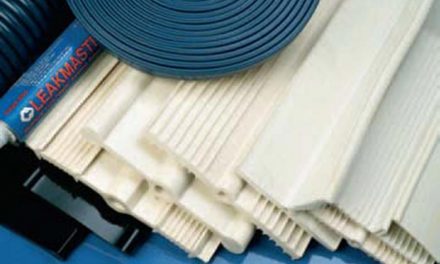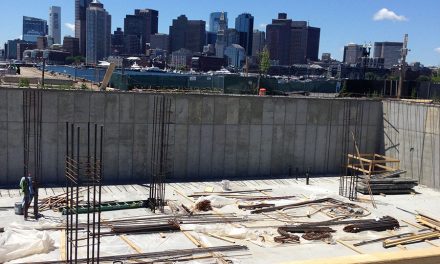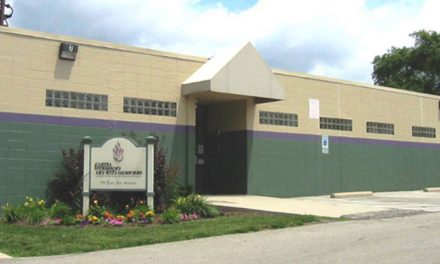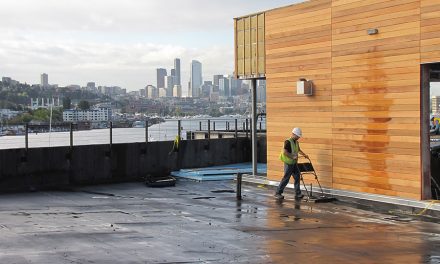Dealing With Water Issues On Existing Buildings
— By Melissa Morton
Remediating the waterproofing and drainage for a New England hotel involved installing a 60-foot-long French drain under the hotel deck.
Even though the beachfront hotel in Connecticut was only three years old, it was already seeing water in the basement. The owners tried several different techniques to keep the water out, but nothing seemed to work. Even curtain grouting, a system that injects grout to the blindside of the foundation to stop leaks, didn’t work for this particular project.
In the end, they hired a crew to install an interior remedial waterproofing system that collected the water as soon as it entered the building and diverted it out of the structure immediately.
“If you can’t stop the water from coming in, the next best thing is to control where the water goes when it does come in,” says Jason Weinstein of Budget Dry Waterproofing, Inc., based in nearby Guilford, Conn.
This particular project had water issues for a few reasons. The unique location and its proximity to the ocean were definitely contributing factors.
However, water comes into buildings and homes many different ways. “Understanding where and how the water can enter a basement makes it easier to address the issue,” Weinstein says.
The first part of the solution was for Weinstein and his crew to build a holding tank to create a place for the water to go. They used a bio diffuser system that collects the water into a series of perforated polypropylene chambers buried in gravel like an enormous French drain. The drain trench was 6 feet wide, 4 feet deep and 60 feet long. The only location on the property for such a large structure was underneath the hotel deck. Because the location, the Budget Dry crew couldn’t use any heavy equipment for excavating. “It had to be done all by hand,” says Marc Weinstein who was also on the project. “It was a complicated and involved project on an open and running hotel.”
Weinstein’s crew worked during the off hours of the hotel restaurant. They could only work between breakfast and lunch then stop for the lunch hours and start back up again for a few hours before the dinner rush. They also had to work as quietly and quickly as possible.
“Working on water issues in an existing building will disrupt the normal routine, whether it is a business or a house,” Weinstein says. “It is hard for homeowners but much harder for a place of business. If we were too loud, the busy hotel had to comp rooms to combat complaints.”
Once the trench was excavated, the chambers in place, and buried in gravel fill, a 155-foot-long, above-grade discharge line was installed, connecting the waterproofing system in the hotel basement with the new holding chamber.
While this hotel’s problems may sound extreme, wet basements are actually quite common in both commercial and residential structures.
The most common places for water to enter an existing basement are:
- Over the sill plate. (high water tables)
- At the cove (where the wall meets the floor).
- Through a basement window.
- Through cracks in the foundation wall.
- At the form seams (poor concrete workmanship).
- Through pipe penetration. (Where the water line, sewer line, and/or sump pump lines enter the basement. )
- Up through the floor or through the wall due to hydrostatic pressure building up in the soil.
Knowing the location of the water intrusion will help determine the most appropriate solution.
The next step is to determine the source of the water. An exterior inspection will frequently reveal the source. Grade issues, yard drainage problems, saturated soils, and faulty gutters and downspouts are common culprits. Frequently, by eliminating exterior drainage issues, the cause of water building up next to the foundation is resolved and the basement issues are resolved. But not always.

Through careful scheduling, crews minimized disruption to the guests.
Chris Mancuso of Accurate Basement Repair in Milwaukee, Wisc., is a Certified Structural Repair Specialist (CSRS) and Certified Waterproofing Specialist (CWS) through the Basement Health Association. He says water problems can also arise from weather and soil conditions such as shrinkage, frost, soil expansion, or frozen downspouts. “Sometimes it is from poor workmanship during the construction,” he says. “If the builder applied the membrane too thin or missed a spot on the exterior wall, it can cause water leaks.”
Foundation cracks are another extremely common place for water to come into a basement. And sadly, all concrete foundation walls and floors will crack over time. Luckily, the foundation repair industry has developed techniques to fix concrete cracks. Crack injection systems use either polyurethane (water only) or epoxy (for structural issues). It is important that these cracks are completely filled and bonded to solve the problem.
If there are no cracks, gaps or holes in the wall and water is still coming into the house, it may be hydrostatic pressure. When water seeps up through the concrete floor or through the walls without any visible cracks, it is a sign that water is saturating the outside soil beneath the foundation and pushing the water through the concrete. To relieve hydrostatic pressure, drainage must be installed. This is the solution Weinstein and his crew installed at the Connecticut hotel. For residential homes, this means removing the water source as well as installing interior drains and pumps to divert the water that is getting inside.
Many times hydrostatic pressure builds up outside the foundation wall because of grading issues and outside drainage neglect. Water runoff should not be able to collect near the foundation. If the soil near the home is sloping toward the house, it can sometimes be built up by adding fill. However, Mancuso warns that the fill can be too high on the foundation wall and also cause issues. “If the grade goes above the foundation wall,” he says, “then the water comes into the basement because the fascia is not protected by the waterproofing membrane.”
The location of the lot also impacts water intrusion. This was the case with the beachfront hotel. If there is a high water table, as often happens near a wetland, lake, river or pond, the water can infiltrate the soil and enter the basement. In these cases, the water can be managed, Mancuso says. “You dewater the foundation with pumps,” he says. “The pumps run constantly but the basement is dry. Just think of places like Venice. You can build next to water, but it just takes work to keep them dry.”

Due to space constraints, the excavation and backfilling was done entirely by hand.
While outside water sources are common, there are times when the water problem comes from an internal source. It may be a leaky faucet, plumbing problems, or moisture issues from how the space is used. This interior water needs to be addressed and needs a way to escape.
“Whether it is an internal or external water source, the same properties of water still apply,” Weinstein says. “Remedial waterproofing is about controlling and managing the water.”
Melissa Morton is a freelance writer and the newsletter editor for the Basement Health Association. BHA is a nonprofit trade association for waterproofing and structural repair contractors, crawlspace contractors, basement remodelers, radon and mold mitigation contractors and all other contractors whose work affects the overall basement environment. For more information, visit www.basementhealth.org.
Closed vs. Open Drainage Systems
Summer 2015 Back Issue
$4.95
Remedial Waterproofing
Green Roof Profile: Bulls Practice Facility
Sealing Manholes And Water Tunnels:
Green Roof Directory
AVAILABLE AS DIGITAL DOWNLOAD ONLY
Description
Description
Remedial Waterproofing
By Melissa Morton
Keeping water out of an existing below-grade structure is often more complex than new construction. Options include curtain grouting, pumps, crack repair, and drainage systems that collect and divert water from inside the structure.
Green Roof Profile: Bulls Practice Facility
Completed last fall, the Advocate Center is a training facility for the Chicago Bulls basketball team featuring state-of-the-art weight training and practice space on the inside and an 11,300 sq. ft. green roof on top.
Sealing Manholes And Water Tunnels:
By Deb Hammacher
Sealing municipal tunnels—and the manholes that access them—is a significant waterproofing challenge.
Green Roof Directory
Published in conjunction with GreenRoofs.com, this is a comprehensive categorized list of the products and services offered to the vegetated roof industry.
Additional Info
Additional information
| Magazine Format | Digital Download Magazine, Print Mailed Magazine |
|---|

